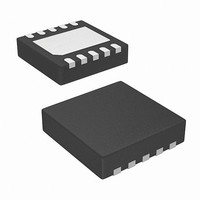ISL22416UFRT10Z Intersil, ISL22416UFRT10Z Datasheet - Page 10

ISL22416UFRT10Z
Manufacturer Part Number
ISL22416UFRT10Z
Description
IC POT DGTL 128TP LN LP 10-TDFN
Manufacturer
Intersil
Series
XDCP™r
Datasheet
1.ISL22416UFU10Z.pdf
(14 pages)
Specifications of ISL22416UFRT10Z
Taps
128
Resistance (ohms)
50K
Number Of Circuits
1
Temperature Coefficient
80 ppm/°C Typical
Memory Type
Non-Volatile
Interface
SPI, 3-Wire Serial
Voltage - Supply
2.7 V ~ 5.5 V
Operating Temperature
-40°C ~ 125°C
Mounting Type
Surface Mount
Package / Case
10-TDFN Exposed Pad
Resistance In Ohms
50K
Lead Free Status / RoHS Status
Lead free / RoHS Compliant
Bus Interface Pins
SERIAL CLOCK (SCK)
This is the serial clock input of the SPI serial interface.
SERIAL DATA OUTPUT (SDO)
The SDO is an open drain serial data output pin. During a
read cycle, the data bits are shifted out at the falling edge of
the serial clock SCK, while the CS input is low.
SDO requires an external pull-up resistor for proper
operation.
SERIAL DATA INPUT (SDI)
The SDI is the serial data input pin for the SPI interface. It
receives device address, operation code, wiper address and
data from the SPI external host device. The data bits are
shifted in at the rising edge of the serial clock SCK, while the
CS input is low.
CHIP SELECT (CS)
CS LOW enables the ISL22416, placing it in the active
power mode. A HIGH to LOW transition on CS is required
prior to the start of any operation after power up. When CS is
HIGH, the ISL22416 is deselected and the SDO pin is at
high impedance, and (unless an internal write cycle is
underway) the device will be in the standby state.
Principles of Operation
The ISL22416 is an integrated circuit incorporating one DCP
with its associated registers, non-volatile memory and the
SPI serial interface providing direct communication between
host and potentiometer and memory. The resistor array is
comprised of individual resistors connected in series. At
either end of the array and between each resistor is an
electronic switch that transfers the potential at that point to
the wiper.
The electronic switches on the device operate in a “make
before break” mode when the wiper changes tap positions.
When the device is powered down, the last value stored in
IVR will be maintained in the non-volatile memory. When
power is restored, the contents of the IVR is recalled and
loaded into the WR to set the wiper to the initial value.
DCP Description
The DCP is implemented with a combination of resistor
elements and CMOS switches. The physical ends of each
DCP are equivalent to the fixed terminals of a mechanical
potentiometer (RH and RL pins). The RW pin of the DCP is
connected to intermediate nodes, and is equivalent to the
wiper terminal of a mechanical potentiometer. The position of
the wiper terminal within the DCP is controlled by a 7-bit
volatile Wiper Register (WR). When the WR of a DCP
contains all zeroes (WR<6:0>: 00h), its wiper terminal (RW) is
closest to its “Low” terminal (RL). When the WR register of a
DCP contains all ones (WR<6:0>: 7Fh), its wiper terminal
10
ISL22416
(RW) is closest to its “High” terminal (RH). As the value of the
WR increases from all zeroes (0) to all ones (127 decimal),
the wiper moves monotonically from the position closest to RL
to the closest to RH. At the same time, the resistance between
RW and RL increases monotonically, while the resistance
between RH and RW decreases monotonically.
While the ISL22416 is being powered up, the WR is reset to
40h (64 decimal), which locates RW roughly at the center
between RL and RH. After the power supply voltage
becomes large enough for reliable non-volatile memory
reading, the WR will be reload with the value stored in a
non-volatile Initial Value Register (IVR).
The WR and IVR can be read or written to directly using the
SPI serial interface as described in the following sections.
Memory Description
The ISL22416 contains one non-volatile 7-bit register, known
as the Initial Value Register (IVR), volatile 7-bit Wiper Register
(WR), and volatile 8-bit Access Control Register (ACR). The
memory map is shown in Table 1. The non-volatile register
(IVR) at address 0, contain initial wiper position and volatile
registers (WR) contain current wiper position.
The non-volatile IVR and volatile WR registers are
accessible with the same address.
The Access Control Register (ACR) contains information
and control bits described in Table 2.
The VOL bit (ACR<7>) determines whether the access is to
wiper registers WR or initial value registers IVR.
If VOL bit is 0, the non-volatile IVR register is accessible. If
VOL bit is 1, only the volatile WR is accessible. Note, value
is written to IVR register also is written to the WR. The
default value of this bit is 0.
The SHDN bit (ACR<6>) disables or enables Shutdown mode.
This bit is logically ANDed with SHDN pin. When this bit is 0,
DCP is in Shutdown mode. Default value of SHDN bit is 1.
The WIP bit (ACR<5>) is read only bit. It indicates that
non-volatile write operation is in progress. The WIP bit can be
read repeatedly after a non-volatile write to determine if the
write has been completed. It is impossible to write to the WR or
ACR while WIP bit is 1.
BIT NAME VOL
ADDRESS
BIT #
2
1
0
TABLE 2. ACCESS CONTROL REGISTER (ACR)
7
SHDN
NON-VOLATILE
6
TABLE 1. MEMORY MAP
IVR
—
WIP
5
4
0
Reserved
3
0
2
0
VOLATILE
ACR
WR
September 9, 2009
1
0
FN6227.2
0
0











